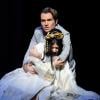
Like many fairy tales, Die Frau ohne Schatten is made of wishes and curses, menace and grace, human striving and supernatural forces, all of it wrapped up in a happy ending. No simplistic accounting of the 1919 Richard Strauss opera, with a libretto by Hugo von Hofmannsthal, can do justice to the technical demands, sprawling scale, magisterial artistry, and unsettling vision of this massive, remarkable work.
In a vibrant return to San Francisco Opera after a 34-year absence, The Woman Without a Shadow filled the War Memorial Opera House to overflowing at its Sunday, June 4 opening. Indeed, with a mighty force of 96 musicians in the orchestra pit and a brass choir, vocal soloists, and two different choruses stationed in the Grand Tier and other offstage locations, the theater became a kind of aural universe for Strauss’s immersive, coruscating score.
Former SF Opera Music Director Donald Runnicles was the master of it all, conducting a vital performance of the score, by turns surging and supple, assertive and sensitive to every dramatic nuance. While the piece calls for heroic singing — none more scintillating than that of soprano Nina Stemme in this production — the greatness of the work inheres in the character, musical poetry, and narrative spine of the orchestral score. Even in the multiple set changes that the three-act, 11-scene work requires over its three-hour-and-45-minute running time, Runnicles and his large ensemble unfurled a captivating through line.

Color is essential as well, whether in the ravishing strings, hard-edged chirp of the woodwinds, or some wonderfully weird touches (a glass harmonica, castanets). All that matched the saturated color palette of David Hockney’s brilliantly inventive biomorphic sets, brought to vivid life by Justin A. Partier’s realization of Alan Burrett’s original lighting design for the 1992 production. Abstract skies become deep purple views of distant lands. A giant curved ramp curls in and out of view. A blunt, imposing temple facade looms over a misty lake. Dispiriting drapes define a dyer’s hardscrabble life.
Two women, from different realms, are the focal points of the symbolic, sometimes murky, and ideologically problematic text. To have a shadow, the story proposes, is to possess the ability to bear children and by extension to fulfill a woman’s meaning and destiny. A choir of angelic unborn children ultimately underscores the case, in a decidedly pro-life, anti-choice message to contemporary ears.
Goaded by her Nurse (an imperiously conniving Linda Watson, in one of three principal soprano roles), a superhuman Empress (a silvery-voiced if underwhelming Camilla Nylund) sets out to steal the shadow of a Dyer’s Wife. Should she fail, a curse decrees, her husband (tenor David Butt Philip, fine in a limited role) will turn to stone in three days. Assorted complications of guilt, greed, temptation, remorse, and reconciliation ensue over the course of the opera.

Stemme, who received the San Francisco Opera Medal onstage during Sunday’s curtain calls, gave a performance as the Dyer’s Wife that ranged from gritty to gilded, earthy to harrowing, and altogether glorious. Early on, in her workaday life with her oblivious husband Barak (bass-baritone Johan Reuter, in a growly, shambolic turn), Stemme’s Wife registered in clipped, almost perfunctory phrases. As her sense of possibilities expanded with promises of love and riches from the steely Nurse and ambivalent Empress, the effortless power and lustrous shine of Stemme’s voice captured the character’s emotional turbulence and labile responses.
Roy Rallo’s direction was not a prominent asset of the production. Sometimes leaving well enough alone was fine, allowing the music and Hockney’s exuberant stage pictures to carry the flow. At other points, especially in the scene-shuttling second act, the action felt stilted. In one amusing touch, dancer Christopher Nachtrab popped up like an alluring jack-in-the-box lover as additional arms waved enticingly from inside the cube.
Whatever misgivings one might have about the story and its implications, Frau’s peak moments were transporting on Sunday. In the magnificent quartet that joins the two couples, the gods seemed more human and the humans more divine. To the end, Stemme led the musical charge. But even as she outshone her fellow cast members, a sense of transforming unity swept across the stage. Literally and figuratively, the opera reached its lofty climax on a potent high note.
SF Opera’s production of Die Frau ohne Schatten plays through June 28.




